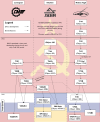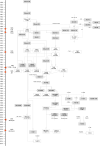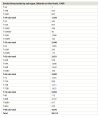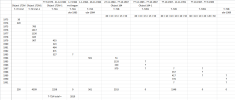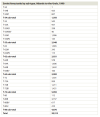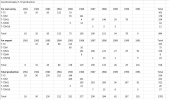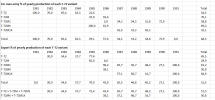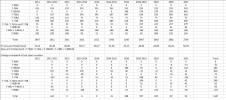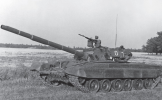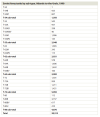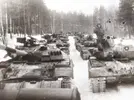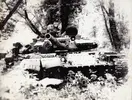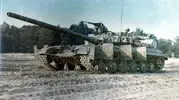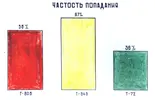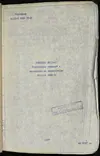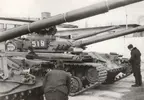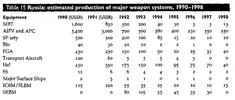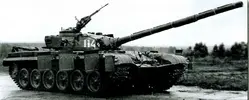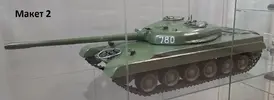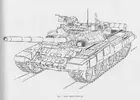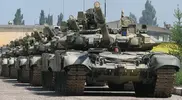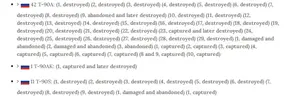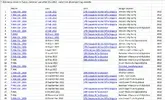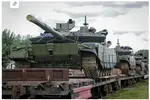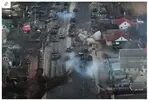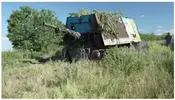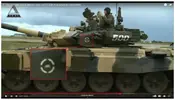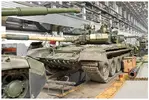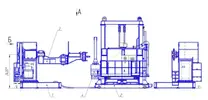Production of Older T-90 Variants
Object 188, which was essentially a continuation of the T-72 tank line, was officially adopted into service under the designation T-90 as Russia’s first post-Soviet tank in October 1992. We will not dwell on the technical features of this model or other details actively debated among tank enthusiasts, and will instead proceed directly to the topic of its production.
During the economically difficult 1990s for Russia, orders for the production of the T-90 became one of the few lifelines that allowed Uralvagonzavod to survive this challenging period. Estimates of the number of tanks produced during that time vary somewhat. According to information
published in Izvestia [The News, a Russian pro-Kremlin daily broadsheet newspaper and a news channel] in 2020, about 150 original Vladimir main battle tanks [called in honor of its chief designer Vladimir Potkin] were produced in the early 1990s. A similar estimate is
provided by Aleksandr Koshchavtsev in his article "T-90: The Russian MBT" (TankoMaster, issues 4-6, 1998), while Aleksey Khlopotov, in "T-90: Russia’s Main Battle Tank" (Weapons and Equipment: Yesterday, Today, Tomorrow, no. 5, 2010),
gives a figure of 120 units. However, upon closer examination of Khlopotov’s work, it becomes clear that he presents a minimum estimate. Since the exact number of tanks in the final production batch is unknown, the true figure likely lies between 120 and 150 units. Although no detailed year-by-year production data exist, it is evident that the production pace during this period was extremely low and likely did not exceed 30 tanks per year. By the beginning of the new millennium, Uralvagonzavod’s contract with the Ministry of Defense had expired and was not renewed. As a result, production of the original T-90 Model 1992 was discontinued.
However, Uralvagonzavod managed to solve the problem of insufficient domestic orders by developing the export variant of the tank—the T-90S—with India becoming its primary customer. Starting in 2001, the plant became fully
occupied with orders for both complete production and the delivery of tank assembly kits (full sets of components and assemblies in disassembled form) for subsequent assembly in India. In December of that same year, the plant
shipped the first 40 tanks,
followed by another 84 units in 2002. Additionally, beginning in 2003, it is likely that Uralvagonzavod
produced the 186 assembly kits stipulated in the contract.
In 2004, the MoD once again placed an order for tanks for the Russian army—this time for the T-90A, a modified variant that reportedly incorporated lessons from the most recent wars at the time. The T-90A was produced by Uralvagonzavod over the following several years. Between 2004 and 2009, Russia manufactured a total of 218-220 T-90A tanks. Production began with 16 units in both 2004 and 2005, increased to 31 units each in 2006 and 2007, then doubled to 62 in both 2008 and 2009 (though some sources report 63 for 2009). It is also known that in 2010, the MoD
planned to procure another
63 T-90A tanks, after which further purchases were reportedly halted (
1,
2). Although some publications indicate that Uralvagonzavod managed to
secure and
fulfill one more T-90A
production contract in 2011, the company itself
states that production ran from 2004 to 2010. Thus, the most likely estimate for the total number of T-90A tanks produced stands at 281-283 units.
At the same time, Uralvagonzavod developed a new export variant of the T-90—the T-90SA—which also proved popular among foreign militaries. While continuing production of tanks for the Russian MoD, the plant signed an agreement in 2006 to
supply 185 T-90SA tanks to Algeria. This contract was
carried out between 2006 and 2009, with deliveries including 30 tanks in 2006, 102 in 2007 and another 53 in 2008-2009.
At the end of 2007, a new contract was
signed with India under which 124 fully assembled tanks were
delivered between 2008 and
2010 (24 in 2008, 80 in 2009 and 20 in 2010), along with 223 assembly kits (the delivery of which was
completed in 2011). In 2009, reports
indicated the signing of an additional agreement for the delivery of another 50 assembly kits, though there is no publicly available information confirming whether this contract was fulfilled. Under a
contract with Turkmenistan, 10 tanks were produced between 2010 and 2011 (6 in 2010 and 4 in 2011), while
44 tanks were
shipped to
Uganda in 2011.
Between 2012 and 2013, Uralvagonzavod manufactured 120 tanks under a second order for Algeria (
1,
2,
3,
4). In 2013-2014, the company produced another 100 tanks for Azerbaijan (
1,
2,
3,
4,
5). In 2014, a third contract with Algeria was
signed, under which Uralvagonzavod was to deliver
200 T-90S tanks. This contract was fully completed between
2015 and the end of
2016. In the same year, 2016, two more contracts were
signed. Under the first, with
Iraq,
75 tanks were delivered—36 produced in 2017 and another 39 in 2018. Vietnam purchased 64 tanks, which were
manufactured in 2018 and
delivered in two batches (
1,
2).
In 2020, another batch of T-90A tanks was
delivered to Algeria, likely under a new, fourth contract. However, no information about the signing of this contract—nor about its volume or delivery timeline—has appeared in open sources. Additionally, the media has occasionally reported rumors about several other countries expressing readiness to sign additional contracts with Uralvagonzavod, but we have found no evidence confirming such agreements or the actual shipment of tanks.
Thus, by 2020—the start of production deliveries of T-90M tanks to the RuAF—Uralvagonzavod had produced between 120 and 150 original T-90 tanks for the Russian army, as well as 281-283 T-90A tanks. The total fleet of tanks in this line can therefore be estimated at 400 to 430.
In addition, the plant also produced export variants of the tank in significant volumes. The chart below shows the plant’s estimated production output during the 2000s and 2010s. It is worth noting that we used the maximum estimates of production figures. It is also important to point out that the distribution of tank assembly kits for India by year is approximate, as precise data is not available. Furthermore, we treat the production of a kit as equivalent to the full production of a tank—although in reality, this is not entirely accurate. For example, during World War II, final assembly accounted for about 25-30% of the total labor involved in tank production. Accurate figures for modern tanks are unknown, but are likely even higher.
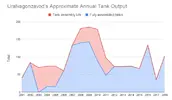
Nevertheless, even without accounting for the production of tank assembly kits, the plant was capable of producing up to 140 tanks per year at its peak. Over a 20-year period, it exceeded the 100-tank-per-year mark six times. The fact that assembly kit production was carried out in parallel during peak years indicates that the production of armored hulls, turrets and other basic components was not operating at full capacity. This suggests that the plant had the potential to increase output of fully assembled tanks to as many as 180 units per year. From this, it can be concluded that Uralvagonzavod retained significant production capacity throughout the difficult years of the 1990s and 2000s for the Russian defense industry. However, this did not prevent the accumulation of debt, which ultimately led to the plant being
transferred in 2016 to the Rostec state corporation. That said, as shown above, the workshops, foundries, machine tools and assembly lines had been largely preserved by that time. The likelihood that this segment of Uralvagonzavod’s production capabilities suffered major losses following the transfer to Rostec appears low.
Pre-War Fleet of Older T-90 Variants
Before examining the production of T-90M tanks specifically, let us revisit our assessment of the earlier T-90 tank variants. As noted above, Uralvagonzavod manufactured between 120 and 150 original T-90 tanks for the Russian army, along with 281 to 283 T-90A tanks. The total number of these variants can be estimated at 400 to 430 units.
Let us attempt to refine this estimate. As a starting point, we can refer to a
statement made in early 2020 by Alexey Krivoruchko, Deputy Russia’s Minister of Defense, indicating that at that time (before T-90M tank deliveries began) the Russian army had only about 400 T-90 tanks of various modifications—a figure that aligns with our lower estimate. The previously mentioned Izvestia
article from April 2020 stated that approximately 150 vehicles were produced in the early 1990s (the original T-90) and another 240 or so between 2004 and 2011 (the upgraded T-90A variant), a number that falls below even our lowest estimate.
For a more precise assessment, let us compare these figures with data on the number of tanks actually deployed with military units. According to
calculations by the analyst Aleksey Karpychev, who closely tracked Russian army equipment and weaponry, by 2021 the Russian army had approximately 190 T-90A tanks in service.
Of these, 40 were in service with the 27th Separate Motorized Rifle Brigade, with another 27 tanks in the tank battalion of the 1st Motorized Rifle Regiment of the 2nd Motorized Rifle Division. Beyond these units of the 1st Tank Army in the Western Military District, T-90A tanks were also in service with the Southern Military District: 40 tanks in the then-recently deployed 20th Motorized Rifle Division of the 8th Combined Arms Army and another 80 tanks in the 58th Combined Arms Army: 40 tanks in service with the 136th Separate Motorized Rifle Brigade and another 40 with the 429th Motorized Rifle Regiment of the 19th Motorized Rifle Division.
Additionally,
41 T-90A tanks were
stationed at the 7th Military
Base of the RuAF in Gudauta, Abkhazia [autonomous republic in northwestern Georgia that formally declared independence in 1999], while another 40 or so T-90 and T-90A tanks ended up in
Syria (some were
part of the Russian expeditionary force, others
were transferred to Bashar al-Assad's regime and various local
formations, with at least
several units
lost as far
back as the 2010s, and
no fewer than 6 vehicles captured by Syrian opposition forces during the offensive that led to the fall of Assad's regime).
Furthermore,
according to OSINT analysts who track military equipment through satellite imagery of storage facilities, at least 112 additional T-90 tanks were stored in the open before the invasion began—all at the 22nd Central Tank Reserve Base near the town of Buy in the Kostroma region. Thanks to publicly available photographs from this facility, we can identify these tanks as T-90 Vladimir main battle tanks.

T-90 tanks, 1992 model, 22nd Central Tank Reserve Base, Buy, Kostroma region
Therefore, we arrive at an estimate of 230 T-90A tanks in the RuAF, at least 112 T-90 tanks at the storage base and another 40 T-90 and T-90A vehicles (the exact ratio is unknown) in Syria. This almost perfectly aligns with the minimum estimates we cited earlier. However, it seems highly unlikely that all existing tanks came into view. Presumably, some additional number of both T-90 and T-90A tanks could have been kept in enclosed storage hangars or otherwise escaped observation. For instance, during the invasion it came to light that Russia
possessed export T-90S tanks, which only became known when they were withdrawn from storage for dispatch to the frontline—no information about this had surfaced previously. Therefore, in our view, the most realistic estimate appears to be 130-140 T-90 tanks and 281-283 T-90A tanks (about 40 of which were in Syria). This is the figure we will rely on going forward.

* of which from 370 to 380 units in service with the RuAF, not counting the "Syrian" tanks
Pre-War T-90M Production
Deliveries of the latest T-90M tanks began even before the full-scale invasion of Ukraine. The MoD
signed the first contract with Uralvagonzavod in August 2017. It
stipulated the modernization of 20 existing T-90 tanks to the T-90M standard and the production of 10 newly built T-90M tanks between 2018 and 2019. Thus, in the initial production phase, the ratio of newly built to upgraded tanks was 1:2 (not 1:3, as stated in Gjerstad’s article). A year later, in August 2018, a second contract was
signed for deliveries in 2019. According to unofficial data from the Centre for Analysis of Strategies and Technologies (CAST), which is closely linked to the Russian defense industry, this contract also covered a battalion set of 30 tanks, described as "newly built." While this suggests they were produced from scratch, there is no documentary confirmation. A third
contract followed in August 2019, covering the overhaul and modernization of T-90A tanks to the T-90M standard. Again, according to unofficial CAST data, this contract involved the modernization of approximately 100 tanks, possibly not T-90A but older T-90 models from the 1990s (likely sourced from the 22nd Central Tank Reserve Base). The delivery timeline for this contract was not disclosed. Meanwhile, Izvestia
reported in April 2020 that the first tanks to be modernized to the T-90M standard would be the previously mentioned vehicles from the 7th Military Base in Abkhazia. Finally, in summer 2021, a fourth contract was
signed for both new production and modernization of T-90 tanks to the T-90M level. However, no information was released regarding delivery deadlines, quantities or the ratio between new and upgraded tanks. Overall, in the pre-war period, four contracts were signed covering the delivery of at least 160 T-90M tanks. According to unofficial data, 40 of these were newly built and 120 upgraded. The lack of detail on the fourth contract does not significantly affect this estimate, as it was signed only a few months before the invasion and likely not fulfilled in time.
As for deliveries under the signed contracts, they, as is often the case in the Russian army, experienced delays. Tanks covered by the first 2017 contract, which was due for completion in 2018-2019, were only delivered in 2020: in April, the 1st Motorized Rifle Regiment of the 2nd Motorized Rifle Division
received 20 tanks, and in November, 10 T-90M tanks were
sent to the Kazan Higher Tank Command School. Five months later, in March 2021, Uralvagonzavod
announced the delivery of a new batch of T-90M tanks, apparently as part of the second (2018) contract. The 27th Separate Motorized Rifle Brigade
received eight tanks. Later that summer, the aforementioned General Krivoruchko
stated that in 2021, the army would receive 65 production T-90M tanks. According to Uralvagonzavod Director Vladimir Roshchupkin, 26 units had already been shipped by then. Thus, by mid-2021, Uralvagonzavod had essentially completed the 2018 contract. It is also worth noting that,
according to Roshchupkin, "both absolutely new vehicles and T-90A tanks upgraded to the T-90M standard" were supplied. This contradicts CAST's earlier claim that the 2018 contract was for "newly built tanks." Therefore, it can be possibly assumed that the second contract may have included 10 new tanks and 20 upgraded from existing stocks. We also note that initially, only T-90A tanks, not the older 1992 T-90s, were being upgraded. Uralvagonzavod reported a new shipment after the start of the full-scale invasion, in May 2022.
Video evidence shows at least 10 tanks shipped at that time, likely under the 2019 contract.
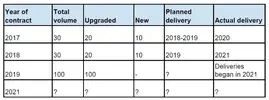
In summary, despite the obvious initial problems with organizing serial production of T-90M tanks, Uralvagonzavod eventually resolved these issues and began regular deliveries, albeit several years later than originally planned. It is worth noting that production rates increased during 2020-2021: over eight months from April to November 2020, 10 tanks were produced; over the next five months (by March 2021), the factory produced eight tanks; and after another six months (by August 2021), 18 vehicles were delivered. The factory aimed to reach an annual production rate of 65 tanks, including both newly built and upgraded vehicles.
Given the accelerated rate, it can be assumed that the factory could have produced at least several dozen additional tanks by the end of the year that were not publicly reported. If we assume that Uralvagonzavod successfully fulfilled its 2021 plan, up to 39 more T-90M tanks may have been supplied. Thus, by the time of the invasion, the RuAF could have had 66 to 85 T-90M tanks in service, plus another 10 at the Kazan Higher Tank Command School. Of these, at least 40 were upgraded T-90A tanks.
Therefore, by early 2022, the Russian army had 65-85 T-90M tanks and 410-420 older variants. However, from the latter category, at least 40 tanks that were upgraded to the T-90M standard must be subtracted. Consequently, the total number of older variants should have been 370-380 units, and the total number of T-90 tanks of all modifications was approximately 435-465.
It is worth noting that, according to The Military Balance 2022, the Russian army had 350 T-90A tanks, 67 T-90M tanks and about 200 T-90 tanks of various versions in storage, totaling 612 tanks of this type. As we have shown above, this estimate appears to be overstated by at least 150 vehicles.
ARTIKKELIN LAINAUS JATKUU SEURAAVASSA VIESTISSÄ
